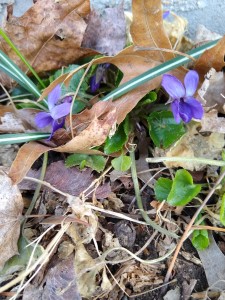 The violets in my garden, mostly purple, white, and freckled varieties of Viola sororia, are long gone, with only their heart-shaped leaves to remind me that they will be among the first out of the ground next spring. Somehow though, violets keep cropping up in my orbit. Last summer, I read the wonderful Violetta, by Isabel Allende. Now, I am reading another book, translated from French, with a protagonist named Violette. Last night, in need of comfort of the horticultural variety, I turned to one of my favorite mid twentieth century garden writers, Beverley Nichols. In the chapter that I read just before sleep set in, Nichols was extolling the virtues of fragrant Parma violets.
The violets in my garden, mostly purple, white, and freckled varieties of Viola sororia, are long gone, with only their heart-shaped leaves to remind me that they will be among the first out of the ground next spring. Somehow though, violets keep cropping up in my orbit. Last summer, I read the wonderful Violetta, by Isabel Allende. Now, I am reading another book, translated from French, with a protagonist named Violette. Last night, in need of comfort of the horticultural variety, I turned to one of my favorite mid twentieth century garden writers, Beverley Nichols. In the chapter that I read just before sleep set in, Nichols was extolling the virtues of fragrant Parma violets.
For reasons that I can’t fathom, violets are dogging me.
The “language of flowers”, which assigns different emotional meanings to various types of blossoms, has been around in one form or another since ancient times. It reached a peak during the Victorian era and persists to this day. Florists and marketers probably make more use of this “language” now than ordinary mortals, but it survives, waiting for another moment in the spotlight. The generally reliable Old Farmer’s Almanac assigns several virtues to violets, including “watchfulness”, “modesty”, and “faithfulness”. 1-800-Flowers, the online bouquet vendor, confirms that violets have been traditional symbols of fidelity, with white violets also symbolizing a willingness to take a chance on love.
Violets were especially important to Napoleon and his flower-mad first wife, Empress Josephine. After his 1814 abdication, Napoleon vowed to “return with the violets”—meaning in the spring. He eventually made good on the promise, but during his first exile, Bonapartists used the violet as a silent symbol of devotion to the deposed Emperor.
So how can you bring violets into your life when the outdoor violets are enjoying their winter’s rest?
You can opt to take the tried-and-true route and content yourself with the widely available African violets. These are not true violets—members of the genus Viola–at all, but part of the unrelated Saintpaulia genus. Despite the somewhat deceptive violet advertising, African violets are easy to grow indoors, with blooms and leaves reminiscent of the viola clan, and an array of colors, sizes and flower forms. The only caution with African violets is that overwatering will promote root rot and eventual plant death. Hold off adding moisture until the top of the soil feels dry to the touch.
If true violets appeal to you, you can also acquire a Tasmanian violet, Viola banksii, which may or may not be the same as Viola hederaceae, but definitely sports similar flowers and leaves. These low-growing tender plants are often used as groundcovers in their native Australia, but also make good container and hanging basket specimens. The plants sport purple and white blooms and heavily veined leaves that resemble rounded hearts. They are not fussy about light, but prefer more illumination to less. South or east facing windows are best. The Australian natives will appreciate an outdoor vacation in warmer weather, but should be brought in when night temperatures fall below 50 degrees Fahrenheit. The watering requirements are the same as those for African violets, and the plants benefit from the humid environment produced by placing the containers atop trays filled with pebbles and water.
Experts disagree about whether or not garden pansies and violas can flourish indoors over the winter. Like most plants, they thrive best when you emulate their natural growing conditions. The pansies and violas available now in garden centers like it cool; grow them in the cooler parts of your living space, away from direct heat sources. Preferring light shade outdoors, the plants need bright, indirect light indoors. Don’t let your violas dry out, but do not swamp them with water every day. Fertilize with a balanced plant food, diluted, if necessary, according to manufacturers’ directions.
As with all plants, indoor viola survival is a matter of trial and error. If the trial succeeds, you will have color during the cold months. If not, you, like Napoleon, can at least look forward to a return to the garden when the outdoor violets bloom.
Find Tasmanian violets at Logee’s, 141 North Street, Danielson, CT 06239; (860) 774-8038; www.logees.com. Print catalog available.
